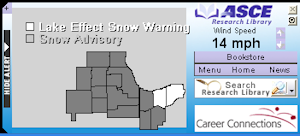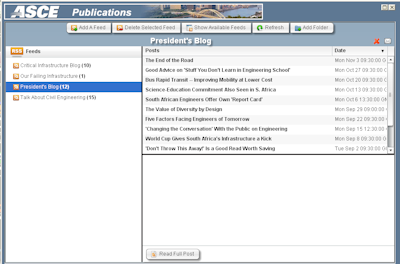Today I received my usual e-mail from ASCE that displays headlines of stories related to civil engineering and was surprised to see ASCE was finally offering a widget for their content. Well now, that was progressive, and I love widgets -sleek, functional, look great on your Website. So I clicked on over to get my very own ASCE widget, download the html, and install it on my Website.
When I got to the site I realized, instead of creating a true widget with tools like Widgetbox or Widgadget, ASCE was offering a program that you install for your desktop. Curious to see what they had set up, I did download the program and noticed that it appeared to be a weather application. This seemed confusing because I thought I was downloading something that would allow me to search and access ASCE content.
It all made sense once the “widget” launched because in the end, it appeared as a small box on my screen that reported weather in my area and had Web links to the ASCE site. The only extra was an RSS display that shows up as an extra window on the screen with feeds from ASCE blogs and the ability to add other RSS feeds.

Now, I am an ASCE member; it is a great organization, but I have to say this is a little disappointing. Most people hooked to the Internet probably already have a weather feed; weather displays seem to be one of the first applications people set up for themselves. And for me, having direct links to specific areas of the ASCE Website sitting on my desktop every day is not really valuable. I would prefer to access the main site when the need arises and go from there. As for the RSS feeds, again, I think most people have chosen their own method of delivery for these. My choice has been igoogle.
So while ASCE has made some strides in creating blogs such as Our Failing Infrastructure, (which I am not sure is such a good title for a blog about something for which we are responsible – think how that comes across to the general public) and they have set up a Facebook group and a group on LinkedIn, they sort of missed the boat on this widget thing.
As a member of ASCE, I would see more value from having a widget created with one of those other tools mentioned above that I could display on my own Website. This method of delivery would allow all members of ASCE to become mini feeds and info points that offer better access to the organization’s content and message. It is time for ASCE to take the plunge and immerse the organization in the viral wonder of Web 2.0.
(An added tip to ASCE: please think about using Twitter to deliver the headline information that you now send out in e-mail. It would really help me stem the rising tide of e-mails.)




